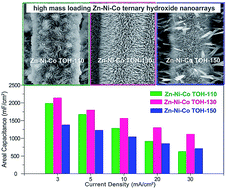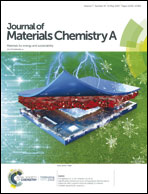Zinc–nickel–cobalt ternary hydroxide nanoarrays for high-performance supercapacitors†
Abstract
The development of high-capacity, stable cycling, and high mass loading cathode materials for asymmetric supercapacitors has been the subject of intense exploration. In this work, a well-aligned zinc–nickel–cobalt ternary (oxy)hydroxide (Zn–Ni–Co TOH) nanostructure with a controlled morphology is used, for the first time, as a high-performance cathode material for supercapacitors. Our findings demonstrate that precursor Zn–Ni–Co TOH materials can deliver superior capacity and rate capability to the Zn–Ni–Co oxide. A high mass loading of 7 mg cm−2 on a carbon cloth substrate is achieved, accompanied by substantially improved facile ionic and electronic transport due to the highly open well-defined nanoarray architecture. The growth mechanism of Zn–Ni–Co TOH was studied in depth by scanning electron microscopy analysis. The optimized Zn–Ni–Co TOH-130 nanowire array electrode delivered an outstanding areal capacitance of 2.14 F cm−2 (or a specific capacitance of 305 F g−1) at 3 mA cm−2 and an excellent rate capability. Moreover, the asymmetric supercapacitor assembled with our Zn–Ni–Co TOH-130 cathode exhibited a maximum volumetric energy density of 2.43 mW h cm−3 at a volumetric power density of 6 mW cm−3 and a long-term cycling stability (153% retention after 10 000 cycles), which is superior to the majority of the state-of-the-art supercapacitors. This work paves the way for the construction of high-capacity cathode materials for widespread applications including next-generation wearable energy-storage devices.

- This article is part of the themed collections: 2019 Journal of Materials Chemistry A Most Popular Articles and Research presented at the International Conference on Emerging Advanced Nanomaterials (ICEAN) 2018


 Please wait while we load your content...
Please wait while we load your content...